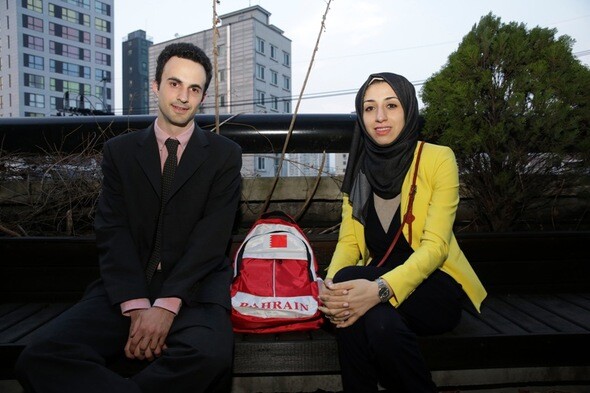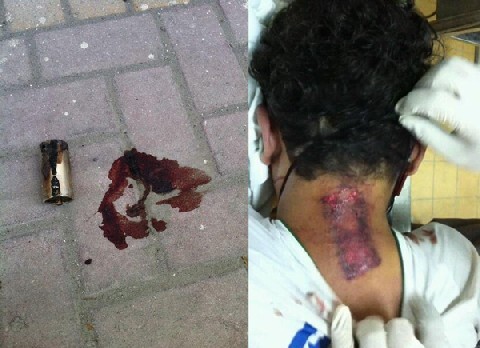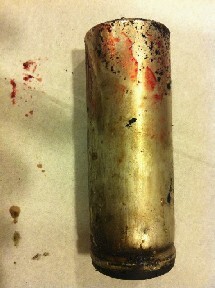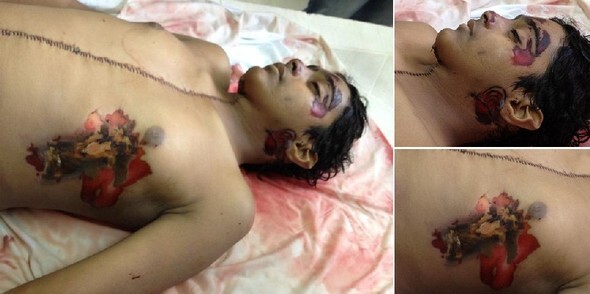hankyoreh
Links to other country sites 다른 나라 사이트 링크
[Interview] South Korea's exports of lethal tear gas to the Middle East

By Shin Woon Dong-wook, Hankyoreh 21 staff reporter
Some seventy people have reportedly been killed by them - young people from direct hits, children from suffocation, elderly people from heart attacks. This was the number they gave for the deaths caused directly and indirectly by them in Bahrain since 2011 and the Arab Spring. When asked about the official figure of 39, they explained that it was the number for the years 2011-13; when recent cases are added in, the figure rises to about 70. Approximately half the 140 people who have died since the democracy protests were killed by South Korean-made tear gas canisters, either from direct hits or suffocation.

Around 1.5 million canisters of South Korean tear gas were exported to Bahrain between 2011 and 2012. An average of 2,000 canisters were used per day in the small island country of 1.2 million people.
If the bloodstained football has stood as a metaphor of the exploitation of child workers, the bloodstained tear gas canister is no metaphor - it’s a reality. South Korea and the Arab Spring are bound together in a loop of tragedy.
On Mar. 18, the Hankyoreh met with members of the group Bahrain Watch, who had come to share information about the misuse and abuse of South Korean tear gas in the country. What they described was a situation where items imported as “non-lethal weapons” are being transformed into something that is very lethal.
Each of the two members had their own images of South Korea before the canisters. Ala’a al-Shehabi, 35, who moved to London after taking part in democracy protests, said she had worked for a Korean once. She thought of South Korea as a “modernized, globalized country.”
Accompanying the hijab-clad Shehabi was Bill Marczak, 28. “I use a Samsung cell phone, and my father drives a Hyundai,” he said, showing the phone he uses. “I’m also a fan of 2NE1 and Nine Muses,” he added with a laugh.
Marczak traveled to South Korea once in 2001, when he was living in Hong Kong with his parents. Familiar with South Korea from K-Pop, he and Shehabi saw their old image of the country replaced by tear gas canisters beginning in 2011. The thick clouds of tear gas erupting on Bahrain are affecting the way the world sees South Korea.

Hankyoreh (Hani): I heard that you didn’t know the tear gas canisters were South Korean at first because they weren’t labeled.
Bill Marczak (Marczak): Before the democratization struggle began in 2011, the tear gas used then was all marked as being from the UK or the US. Once the democratization movement really took off, they started using unlabeled tear gas. We tried looking for the model name for the canisters, but couldn’t find it anywhere. Finally, we were looked on the internet and found a tiny promotional photo on the homepage of a South Korean company. And I found a person holding a tiny Bahraini flag.
Ala'a Shehabi (Shehabi): I had always thought of South Korea a democratic country, a country that is a force for peace, so it was very disappointing.
The two also participated as presenters in a debate on amending the Firearms Control Act held on Mar. 19 at the National Assembly. In the presentation, they noted that records of terrible human rights abuses in Bahrain had already been recorded before Seoul issued an export permit. Despite the evident risk, the exports were not limited.According to the Control of Firearms, Swords, Explosives, etc. Act, exports of tear gas are allowed with the permission of the local police commissioner.
It was not until Bahraini participants in the “Stop the Shipment” campaign sent an email to South Korean peace activists last year that the effects of South Korean-made tear gas canisters came to light.
Late last year, the South Korean chapter of Amnesty International sent a notice to the National Police Agency (NPA) alerting it to the use of South Korean tear gas as a lethal weapon in Bahrain. In January, after meetings among the NPA, Defense Acquisition Program Administration, Ministry of National Defense, and other relevant institutions, the export of South Korean tear gas was finally banned. In 2013, permit applications were submitted for 1.5 million additional canisters for shipment to Bahrain.
The decision had cited the Foreign Trade Act as grounds for “limiting weapons exports for reasons of ‘international peace.’” It was something of an ad hoc move; a more binding legal restriction on tear gas exports was needed. Democratic Party lawmaker Kim Hyun and others responded by pushing to amend the Firearms Control Act to restrict exports of tear gas and related items “in cases where a risk of grave human rights violations is recognized.”
Hani: How were these canisters being used to cause so much damage to people?
Marczak: We keep seeing cases where they are fired directly at people. The government says it’s because the police aren’t trained. But it happens often enough that it has to be some kind of policy.
Shebabi: Two days ago, I heard that someone else had died because of tear gas. [shows a cell phone photo] A friend sent this to me. It’s a picture of a South Korean tear gas canister that fell on the ground near their house. The South Korean tear gas is still being used. If the police don’t see demonstrators, they fire them in all directions. They’ve gone into villages and just fired them indiscriminately, or thrown them through house windows. When tear gas is used like this, it’s basically the same thing as a chemical weapon attack. The government is saying the elderly people all died of heart attacks, the children all had breathing problems, but the real reason they died is because people who were already frail were subjected to tear gas attacks. At least five people have died from direct hits by canisters.
“The only reason that I haven’t been hit by a tear gas canister is pure luck,” said al-Shehabi in her presentation during the debate. Shehabi took part in the democratization protests in 2011. In the presentation, she also testified that tear gas shells are being used like bullets and that the police sometimes fire tear gas shells for the fun of it.Shehabi urged the participants to view a video that can be found by searching for “Bahrain tear gas” on YouTube. In April 2011, a video taken by a citizen of Bahrain was played on an Al Jazeera news report. The video shows a scene of dozens of police officers attacking a lone protester. They shoot tear gas at the unarmed man like bullets. Knocked down by a shell, the man gets back up, clutching his belly, only for the police to shoot him in the neck with another canister.
Other videos corroborate Shehabi’s claim that attacks with tear gas shells have become an everyday occurrence. A CNN news report from Sep. 23, 2011, shows a quiet village covered in darkness. All of a sudden, police officers on patrol lob tear gas shells at a woman who is stopping her car in the distance. The woman, wearing a burka, hurriedly opens the car door because her baby is inside, but not before the tear gas envelops the car.

“I also spoke with an American doctor who treated Ally Sheik, another boy who died in Sitra,” she continued. “The doctor said that the police fired tear gas shells into the boy’s neck without any reason whatsoever,” she said. This was at the peak of Bahrain’s use of South Korean tear gas canisters.
Hani: Why is the issue of tear gas shells so important?
Shehabi: At the beginning of the democratization movement, the government relied on armored vehicles and guns. But it changed its policy after a video of live rounds being fired appeared online and was viewed 2 million times in a single week.
Marczak: The Bahrain government is trying to send a message to the world to say, 'look at us, we only use tear gas'.
Shehabi: Tear gas shells are important because they don’t look like a lethal weapon, but they are in fact being used as a lethal weapon. Now that the import of South Korean tear gas canisters has been banned, they are using canisters imported from South Africa.
Hani: If they can switch importers like that, what is the significance of banning imports from South Korea?
Marczak: While there are about 200 countries in the world, there are not that many countries that export tear gas canisters. By putting pressure on a major exporter such as South Korea, we can also limit the Bahrain government’s ability to abuse the shells. The issue of South Korean-made tear gas shells was covered by news networks such as CNN and BBC. This makes other countries leery of exporting tear gas to Bahrain.
Shehabi: South Korea presents itself as a democratic state, a country that works to promote world peace. That’s why South Korea has to take interest in this kind of issue. We are hoping for the same kind of results in South Africa.
South Korea is a signatory to the Arms Trade Treaty, which forbids the delivery of conventional weapons that have the potential to be used in human rights violations. Furthermore, it is on the board of the UN Commission on Human Rights and is a part of the human rights convention.The UN International Law Commission states that a country that provides assistance to another country despite its full awareness that said country is perpetrating illegal activities overseas is responsible for those same illegal activities. Thus, South Korea has the responsibility to ban exports of tear gas containers, since they sometimes are used as lethal weapons.
[%%IMAGE7%%]While exports to Bahrain have been banned, the problem has not gone away. South Korea exported 470,000 canisters of tear gas to Turkey from 2011 to 2013. It is very likely that a young Turkish man who died on Mar. 11 had been struck by one of the tear gas shells exported by South Korea.
According to a report prepared in 2013 by the staff of Democratic Party lawmaker Kim Gwang-jin about export permits for tear gas shells issued by the Defense Acquisition Program Administration (DAPA), 770,000 tear gas shells were exported to seven countries, including Turkey, Indonesia, and Saudi Arabia. Banning the export of tear gas shells is an urgent matter that demands our immediate attention.
But in fact, this is a bigger issue than just tear gas canisters. During a hearing in the National Assembly about revising the Firearms Act on Mar. 19, Park Seung-ho, an activist with Weapon Zero, gave examples of Egyptian security forces using shotguns recklessly. According to Park’s presentation, a 25-year-old young man named Gaber Ahmed Abdel Bagi died after being hit by security forces firing shotguns. A picture of the man’s back clearly showed where he had been hit by buckshot. It turns out that South Korea exported US$3.11 million worth of shotgun shells to Egypt between 2010 and 2012.
“Even though international human rights organizations have been saying that the way Egyptian security forces have been rashly firing at protestors with shotguns constitutes a grave human rights abuse, South Korea has continued to export shells even after 2010,” Park said.
Shotgun shells - which are generally classified as civilian-use weapons - are not regulated by the Firearms Act provided that they are not being used for a military purpose like tear gas shells. But in places like Bahrain and Egypt, these weapons are also taking people’s lives. For this reason, peace activists argue that potentially lethal weapons for civilian use, which are not currently controlled by the Firearms Act, should also be regulated if there is a clear danger that they will be used in severe human rights violations.
Citing the Convention against Torture, Park suggested that the South Korean government ought to consider the human rights record of the importer, the characteristics of the weapon that will be exported, the end user, and the inherent danger when deciding whether to permit or forbid exports.
In its study of how the government of Bahrain misused tear gas shells between 2011 and 2013, Physicians for Human Rights pointed out that the situation in Bahrain is similar to that of South Korea in the 1980s. The organization's first report dealing with tear gas was about South Korea in 1987.
The sacrifice of Lee Han-yeol - who died after being struck by a tear gas canister - added momentum to the democratization movement in South Korea. As a result of continuing public opposition to tear gas shells, the police ultimately devised a no-tear gas policy in 1998. While Korea may not be able to export the democracy it fought so hard to protect, it certainly should not export weapons that are then used to crack down on democracy movements.
At the end of the debate in the National Assembly, a Bahraini woman asked who would take responsibility. No one at the debate - not the lawmakers, police officers, nor government officials - could answer her.

Please direct questions or comments to [english@hani.co.kr]
Editorial・opinion
![[Guest essay] The real reason Korea’s new right wants to dub Rhee a founding father [Guest essay] The real reason Korea’s new right wants to dub Rhee a founding father](https://flexible.img.hani.co.kr/flexible/normal/500/300/imgdb/original/2024/0423/8317138574257878.jpg) [Guest essay] The real reason Korea’s new right wants to dub Rhee a founding father
[Guest essay] The real reason Korea’s new right wants to dub Rhee a founding father![[Column] ‘Choson’: Is it time we start referring to N. Korea in its own terms? [Column] ‘Choson’: Is it time we start referring to N. Korea in its own terms?](https://flexible.img.hani.co.kr/flexible/normal/500/300/imgdb/original/2024/0423/3617138579390322.jpg) [Column] ‘Choson’: Is it time we start referring to N. Korea in its own terms?
[Column] ‘Choson’: Is it time we start referring to N. Korea in its own terms?- [Editorial] Japan’s rewriting of history with Korea has gone too far
- [Column] The president’s questionable capacity for dialogue
- [Column] Are chaebol firms just pizza pies for families to divvy up as they please?
- [Column] Has Korea, too, crossed the Rubicon on China?
- [Correspondent’s column] In Japan’s alliance with US, echoes of its past alliances with UK
- [Editorial] Does Yoon think the Korean public is wrong?
- [Editorial] As it bolsters its alliance with US, Japan must be accountable for past
- [Guest essay] Amending the Constitution is Yoon’s key to leaving office in public’s good graces
Most viewed articles
- 1[Column] ‘Choson’: Is it time we start referring to N. Korea in its own terms?
- 2[Guest essay] The real reason Korea’s new right wants to dub Rhee a founding father
- 3New AI-based translation tools make their way into everyday life in Korea
- 4Opposition calls Yoon’s chief of staff appointment a ‘slap in the face’
- 5Senior doctors cut hours, prepare to resign as government refuses to scrap medical reform plan
- 6Why Korea shouldn’t welcome Japan’s newly beefed up defense cooperation with US
- 7[Editorial] Japan’s rewriting of history with Korea has gone too far
- 8Terry Anderson, AP reporter who informed world of massacre in Gwangju, dies at 76
- 9[Column] Has Korea, too, crossed the Rubicon on China?
- 10[Column] The clock is ticking for Korea’s first lady